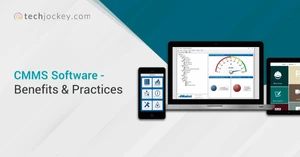What is a Computerized Maintenance Management System (CMMS)?
A Computerized Maintenance Management System (CMMS) is like the brain behind an organization's maintenance operations. It revolutionizes how maintenance tasks are planned, executed, and monitored across various industries.
CMMS software simplifies the complexities of maintenance management by offering simple user interfaces and intuitive capabilities. From scheduling routine check-ups to addressing unexpected breakdowns, maintenance management system ensures smooth maintenance workflows.
At its core, a CMMS system acts as a unified hub for crucial information on the status of the equipment and its maintenance record. This centralized database enables maintenance teams to make informed decisions, optimize resources, and implement proactive maintenance strategies.
How Does a CMMS Work?
Understanding how a CMMS operates is essential for smooth operations. Here is how it works;
- Enter data into the system and create work orders: Start by inputting data into the CMMS software and generating work orders to initiate maintenance tasks.
- Process work order data: The maintenance management system processes the data within work orders once maintenance activities are completed, including asset information, repair details, and job duration.
- Review completed work and close work orders: After maintenance tasks are finished, review the completed work and close the associated work orders within the CMMS.
- Generate reports for informed decisions: CMMS software converts processed data into reports to help maintenance managers make informed decisions.
- Create orders for work requests: Maintenance teams utilize CMMS to create work orders for maintenance requests, including preventive maintenance and inspections.
- Automate order generation based on sensor data: Some CMMS programs automate order generation using asset sensor data that streamlines the maintenance process.
- Mark orders as complete and update data: Once maintenance tasks are fulfilled, mark the corresponding orders as complete and update system data to facilitate report generation and forecasting.
- Utilize mobile CMMS solutions: Mobile CMMS system enables employees to access and update asset data remotely for better maintenance process.
EAM vs CMMS: What’s the Difference?
CMMS software is designed to simplify everyday maintenance management task such as assigning and executing work requests, performing preventative maintenance chores and inspections, and managing spare parts inventories and labor resources to maintain maximum equipment availability.
On the other hand, Enterprise Asset Management (EAM) covers an asset's whole lifespan, beginning with its design and installation and continuing through ongoing maintenance until its retirement or replacement.
Best CMMS Software Comparison
Here is a comparison table of some of the best CMMS software solutions along with their features and prices;
| Top 10 CMMS Software Comparison |
| Softwares | CMMS Software Features | CMMS Software Prices |
| iMaint CMMS | Asset Management, Preventive Maintenance, Parts Management, Work Order Management, Inventory Management | Price On Request |
| Cryotos CMMS | Asset Management, Asset Tracking, Preventive Maintenance, Workflow Automation, Work Order Management | Starting at ₹3,190 |
| MaintainX | Inventory management, Work order management, Asset tracking, Real-time analytics, Compliance management | Free |
| Hippo CMMS | Asset Tracking, Preventive Maintenance, Mobile Access, Inventory Control, Technicians Management | Price On Request |
| Limble CMMS | Asset Management, Mobile Maintenance Utilities, Preventive Maintenance, Work Orders, Ticketing | Price On Request |
| ATL-CMMS | Asset Management, Configurable Workflow, Asset Tracking, IT Asset Management, Management dashboard | Price On Request |
| Maxpanda | Asset Management, Asset Maintenance, Customization, Preventative Maintenance Software, Work Order Management | Price On Request |
| Fiix CMMS | Work order management, Asset tracking, AI for maintenance, Analytics and reporting, Inventory control, Calculate costs for all your assets | Starting at $45/user/month |
| eMaint CMMS | Fixed Asset Management, Inventory Management, Preventive Maintenance, Reporting & Analytics, Vendor Management | Price On Request |
| Opscale CMMS | Asset Tracking, Preventive Maintenance, Inventory Control, Purchasing, Scheduling | Price On Request |
What are the Benefits of a CMMS?
A maintenance management system offers several benefits, ranging from increased visibility to streamlined processes. Following are some of the major benefits it provides;
- Asset visibility: All CMMS data is consolidated in a single location, providing managers and teams with quick access to asset purchase details, maintenance data, failure rates, component usage, efficiency metrics, and more.
- Workflows: CMMS programs offer dashboards for real-time visualization of asset status, including location, maintenance schedules, responsibilities, and other relevant information.
- Automation: Maintenance management system solutions automate repetitive tasks like component ordering, inventory restocking, and audit data gathering, saving time, reducing errors, and allowing focus on maintenance over administrative duties.
- Streamlined processes: CMMS facilitates easy tracking and viewing of orders, with the added convenience of exchanging information via mobile devices for better coordination.
- Preventive maintenance: By gathering data from daily activities and instrumentation, CMMS helps establish appropriate asset maintenance strategies that ensure preventive maintenance is conducted before assets encounter issues.
- Documentation: CMMS system enables storage of repair data, documents, and maintenance procedures for easy access and reference.
- Compliance: CMMS software expedites the process of report and dashboard generation for audits which makes compliance requirements much more easier to address without disrupting maintenance operations.
Must-Have Features of a CMMS
Here are the must-have features of a CMMS maintenance solution;
- Work Order Management: In a CMMS, managing work orders is key. It allows users to create, complete, and track tasks efficiently. Notifications alert users when orders are created, keeping them on top of things. They can easily filter and assign tasks, and add notes and checklists for clarity and guidance.
- Maintenance Scheduling: Maintenance scheduling allows assignments to be scheduled and done proactively. Based on conditions like time or asset condition, planned maintenance is triggered to prevent downtime. Multiple calendars help with scheduling, and forecasting maintenance needs ensures timely interventions.
- Asset Management and Tracking: A good CMMS helps in managing and tracking assets effectively. Users can create detailed profiles for assets, tracking performance, usage, and cost data. Generating reports based on asset status and cost gives valuable information for better decision-making.
- Inventory Management: Maintaining appropriate amounts of consumables and replacement parts while reducing costs requires effective inventory management. CMMS software automates purchase workflows and tracks vendor information. Users can view bill of materials (BoM) for assets and sync inventory records for accurate tracking and timely replenishment.
- CMMS Reporting: Reporting functionalities are integral to a CMMS maintenance solution for analyzing maintenance data. CMMS generates reports and dashboards for assessing asset performance and tracking maintenance activities. This feature saves time and helps maintain return on investment (ROI).
- Mobile Management: Mobile management capabilities extend the functionality of maintenance management software by enabling users to access and manage assets remotely. With features like QR scans for asset identification and push notifications for work orders, users can manage tasks on the go. Access to asset profiles and the ability to attach images and notes enhance efficiency.
How to Choose the Right CMMS Software?
When selecting the right CMMS software for your business, it's important to take a number of aspects into account. Here's how to choose the most suitable CMMS system;
- Equipment Usage: Evaluate your equipment and resource management needs. A CMMS helps maintain assets and resources efficiently, so consider the size of your inventory and storage requirements.
- Production Alignment: Look for a CMMS that aligns maintenance tasks with production objectives. In order to increase overall efficiency, it should make it easier for the production and maintenance teams to collaborate.
- Reliability: Ensure the CMMS enables your teams to meet key performance indicators (KPIs) and provides access to relevant and updated data for informed decision-making.
- Configurability: Opt for a flexible CMMS software that can adapt to your unique maintenance requirements. It should offer customizable features to meet the specific needs of your industry, company, and maintenance team.
- Training and Professional Services: Choose a CMMS provider that offers comprehensive support, including training, implementation assistance, and long-term professional services. This ensures smooth integration and ongoing support for your maintenance operations.
- Ease of Use: Prioritize user-friendly maintenance management system that offers intuitive navigation and easy access to insights. The software should simplify maintenance tasks and make it easier for users to explore and successfully use its capabilities.
- Mobile CMMS / Work Order Software App: Consider CMMS programs with robust mobile capabilities, including a user-friendly work order software app. Mobile access allows maintenance teams to access real-time data and insights from anywhere, enhancing productivity and responsiveness.
Who Uses CMMS Software?
CMMS software is utilized by a diverse range of industries and professionals to streamline maintenance operations and optimize asset management. Following industries benefits from using CMMS software;
- Manufacturing: Maintenance professionals in manufacturing industries rely on CMMS software to minimize downtime and disruptions in production processes. It helps in scheduling tasks, managing inventory, and planning maintenance activities efficiently.
- Education: Educational institutions, including schools and colleges, utilize CMMS software to maintain and track various resources such as furniture, equipment, and facilities. It enables them to ensure compliance with regulations and enhance operational efficiency.
- Healthcare: Hospitals and clinics employ CMMS software to track medical equipment, improve patient experience, and reduce equipment downtime. It helps healthcare facilities in delivering high-quality care while optimizing maintenance processes.
- Hospitality: Managers in the hospitality industry utilize maintenance management software to streamline operations, manage room availability, and coordinate maintenance tasks effectively. It enhances customer satisfaction and facilitates better resource management.
- Retail: Retail companies use CMMS software to organize operations, manage work orders, and protect assets efficiently. It enables real-time communication, smooth workflow management, and effective resource utilization.
- Construction: Construction companies benefit from CMMS software to maintain and repair expensive machinery, allocate resources effectively, and manage work orders efficiently. It ensures timely maintenance and enhances productivity on construction sites.
Modules of CMMS Software
A Computerized Maintenance Management System comprises various modules that facilitate efficient maintenance management. Following are the key modules of CMMS software;
- Work Order Management System: Coordinates and monitors all work order operations from start to finish, including real-time updates for increased efficiency.
- Preventive Maintenance System: Schedules and monitors preventive maintenance tasks to ensure optimal working condition of assets, reducing unplanned downtime and extending asset lifespan.
- Inventory Management System: Tracks and manages spare parts and materials required for maintenance tasks, maintaining adequate stock levels to prevent delays in repairs.
- Asset Management System: Stores comprehensive details about each asset, including installation date, maintenance history, and lifespan, facilitating informed decisions regarding asset maintenance and replacement.
- Reporting and Analysis System: Generates various reports and provides critical insights and analytics to support data-driven decision-making by maintenance managers, identifying trends and patterns for continuous process improvement.
Implementation of CMMS Software
Implementing a CMMS can be challenging but rewarding for the organizations. By following a structured approach and key strategies, you can assure a smooth implementation. Here's how to implement maintenance management software effectively;
- Securing Management Buy-In: Convincing leadership about the value of CMMS is crucial. Present a comprehensive business case highlighting cost savings and increased productivity.
- Preparing for Change: Address staff concerns and involve them in the implementation process to mitigate resistance. Emphasize that CMMS aims to support their work, not replace them.
- Defining Requirements and Goals: Clearly outline business objectives, maintenance goals, and key requirements. Setting realistic and quantifiable targets can help to lead the implementation process efficiently.
- Selecting the Right CMMS Provider: Choose a CMMS provider that aligns with your organization's needs and offers robust support services for long-term success.
- Creating a Project Schedule: Collaborate with internal stakeholders and the CMMS provider to establish a realistic implementation timeline. Define key milestones to track progress effectively.
- Appointing a Leadership Team: Designate a CMMS champion to lead the implementation efforts and assemble a dedicated team with defined roles and responsibilities.
- Data Gathering and Cleaning: Collect accurate data required for CMMS operation and ensure its cleanliness and reliability. Transfer data meticulously and configure it within the CMMS.
- End-User Training: Provide extensive training to users to ensure they grasp the software's capabilities and operations and effectively use it.
- Outlining User Responsibilities: Clearly define user roles and responsibilities to enhance accountability and streamline task completion within the CMMS.
- Conducting User Testing: For optimum performance before launching the CMMS, extensively test it to find and fix any issues that may arise.
- Launching the CMMS: Inform all users about the go-live date and transition to using the CMMS exclusively. Ensure vendor support is available during the launch phase.
- Monitoring and On-the-Job Training: Continuously monitor CMMS usage, address any issues promptly, and provide additional training as needed to optimize performance and user adoption.
How Much Does a CMMS Cost?
The cost of a CMMS varies depending on factors like the size of the business and the features required. Typically, large enterprises in industries such as paper, mining, oil, and gas, fall into Tier 1 and can spend millions or tens of millions of dollars on comprehensive CMMS packages.
On the other hand, Tier 3 companies, which are smaller repair shops with 15 or fewer technicians, may find CMMS programs priced between $25,000 and $100,000.
Tier 2 companies, falling between these extremes, can expect costs that overlap with both Tier 1 and Tier 3, depending on their specific needs and the vendors they engage with.





























